Printable PDF
Breastfeeding is like dancing. If you are going to learn to dance you need to know where to put your body and then how to move your feet. It may feel awkward at first. It might come easily or it may be difficult. But with practice nursing your baby can become second nature. The first thing to think about when breastfeeding is how you are going to position your body and your baby’s body. Once you are in a good position, it will be easier for your baby to latch.
Good positioning and latching is important for building and maintaining your milk supply. When your baby latches deeply onto your breast, your baby is able to remove milk effectively. When your breasts are well-drained, your body gets the message to make more milk. If you are concerned about how much milk you are making, improving positioning and latching is an important first step.
For information on your baby’s very first feeding immediately after birth, please see The First Hours After Birth and Establishing Your Milk Supply.
Note: It doesn't matter whether or not the upper lip is flanged out a lot or not at all. As long as it can form a seal, that's all that's needed.
There's no need to pull your breast back to look at the sides of your baby's lips. This will just pull your breast tissue out of your baby's mouth.

Start with a calm baby. This can be tricky sometimes. If your baby is hungry or has just woken up, she may get upset very quickly. Watch for signs that your baby is hungry. Offer your breast before she starts to cry.

If your baby is crying and upset, it can be tempting to rush to latch her as quickly as possible. However, it is often difficult for a little baby to latch when she is frantically upset.
Early hunger cues include:

Hold your baby skin to skin. Even if your baby is already calm, skin-to-skin contact during feedings is helpful in the early weeks. It helps your baby to know where he is and what he is supposed to do at the breast. Think of your body as your baby’s “habitat” for the first several weeks. The more time your baby spends in skin-to-skin contact with you, the more opportunities your baby has to feed when he is hungry.
For more information please see Skin-to-Skin Care.


Sleepy babies
Your baby may be sleepy. This may be because of birth interventions, medical conditions in the baby or because your baby was born early. Use a laid-back position with skin-to-skin contact to get your baby interested in feeding. In a laid-back position, babies often latch and feed when in light sleep. Thus, it helps to spend a lot of time with your sleepy baby against you. When your baby moves into a light period of sleep and begins to stir, move her near your breast. Get into a comfortable breastfeeding position. This can encourage your baby to latch.
There are many different breastfeeding positions. Some can be more helpful than others in the early stages when you and your baby are learning to breastfeed. These positions include: the cradle hold, the cross-cradle hold, the football hold, side-lying position, and more. One of the best positions for the early days and weeks (and longer!) is called the laid-back position.
The laid-back breastfeeding position is a helpful first place to start if:
Get comfortable. Even little babies get heavy when you are holding them at the breast for hours each day.

Adjust your breast as needed.
It is important for you to have your breast in a place that allows you to rest comfortably while feeding. The following may be helpful:
Ensure full body contact.
If your baby feels completely secure, he will be able to focus on feeding. If he feels insecure, he may wave his arms around or kick his feet in an attempt to hang on to you.


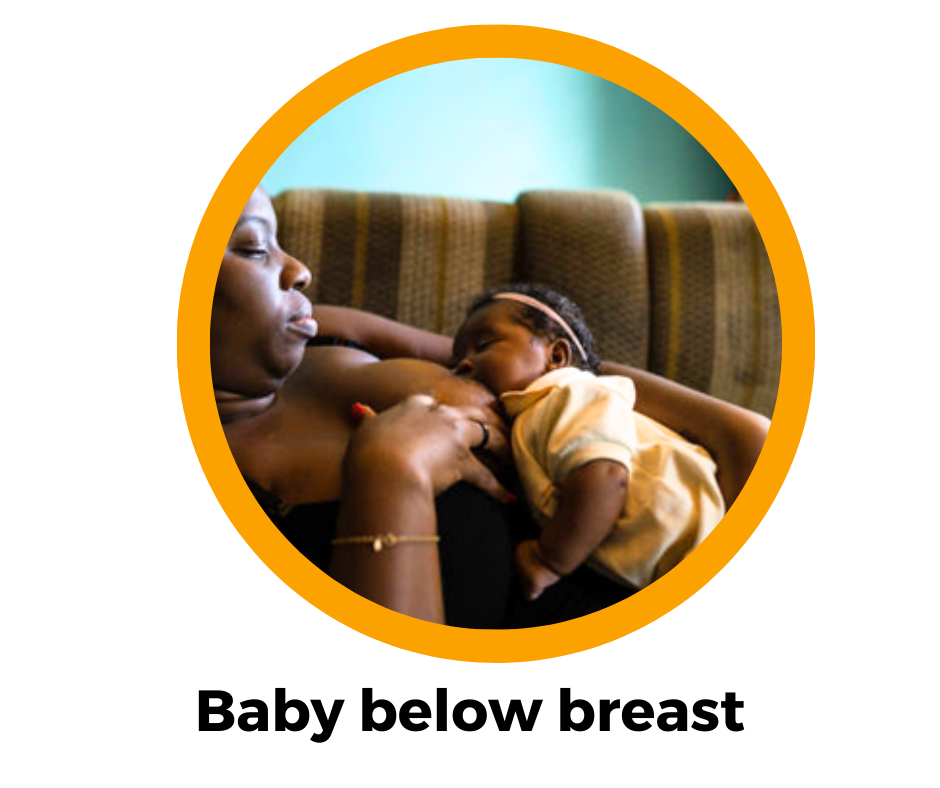
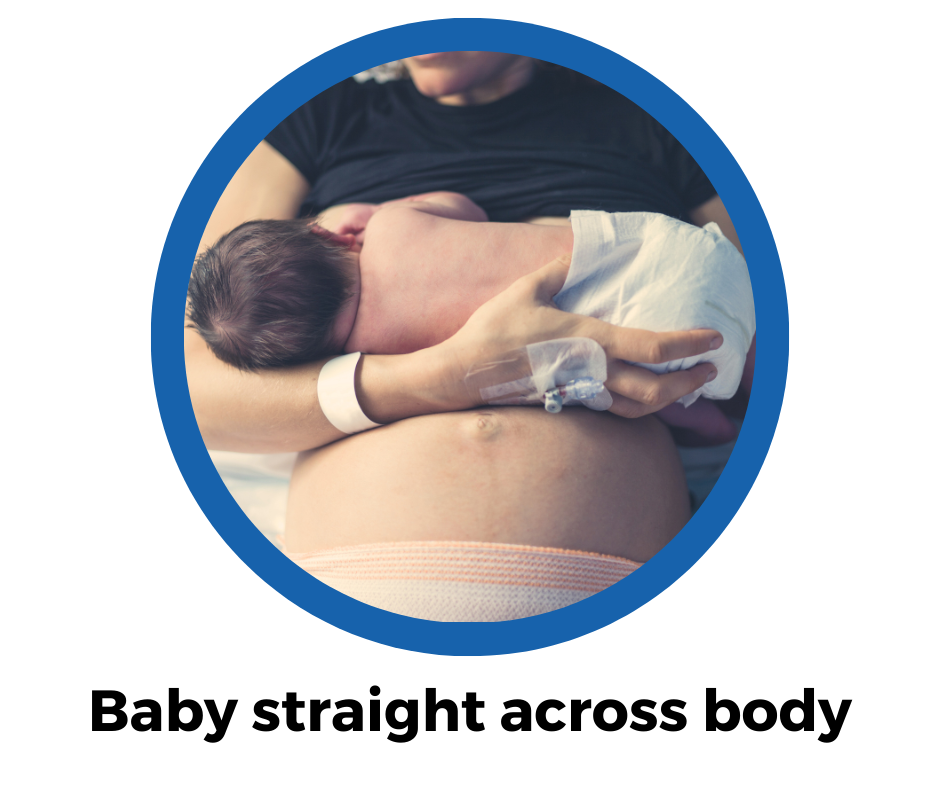
A comfortable, secure position allows your baby to use her instincts to latch deeply onto the breast. With a good latch your baby takes in a large mouthful of breast tissue. This gently stretches your nipple to the back of her mouth. When this happens, your baby is able to effectively remove the milk. A deep latch ensures that your baby gets plenty of milk and your body gets the message to keep making more. It also prevents pain and damage to your nipples.
Chin planted on the breast.
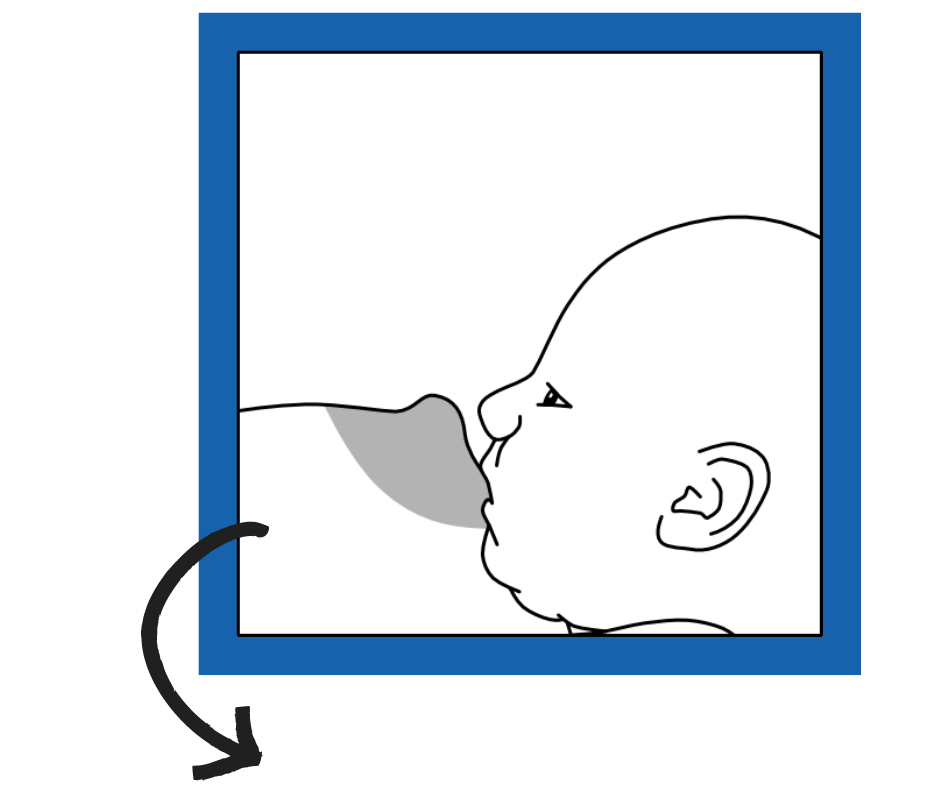
If your baby’s chin is not touching your breast, your baby will often turn his head searching for your breast. When your baby’s chin touches the breast, he smells your nipple. This triggers him to open his mouth wide, reaching up for a big mouthful of breast.
Head tipped back and nose tipping away.
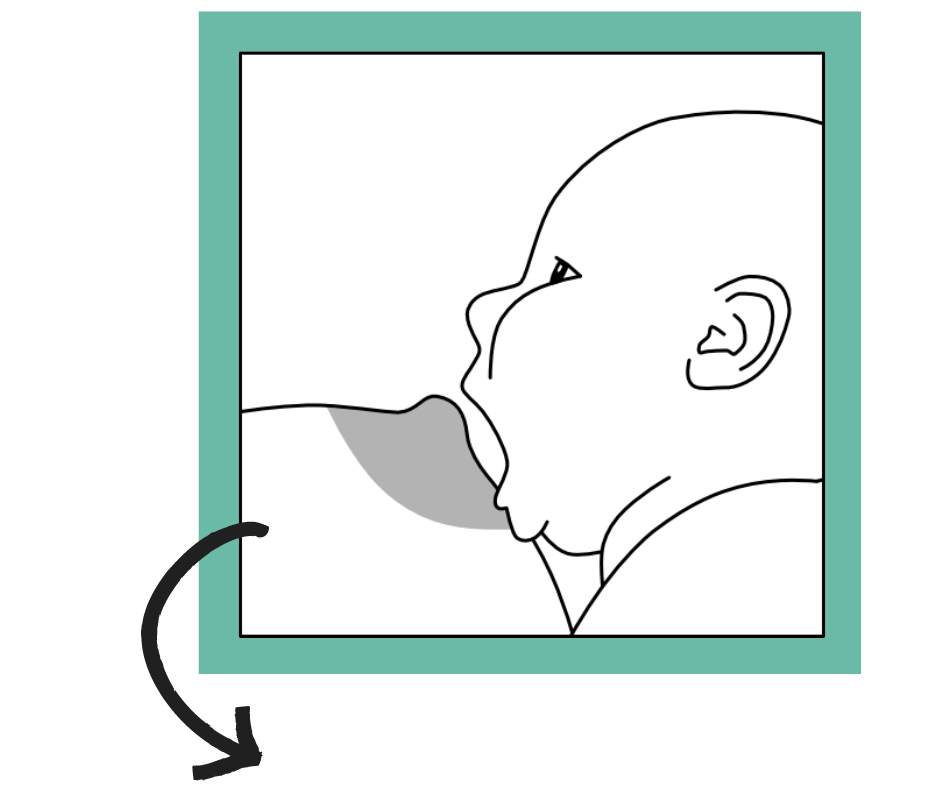
Once your baby is latched, her nose may touch the breast but it shouldn’t be poking into it.
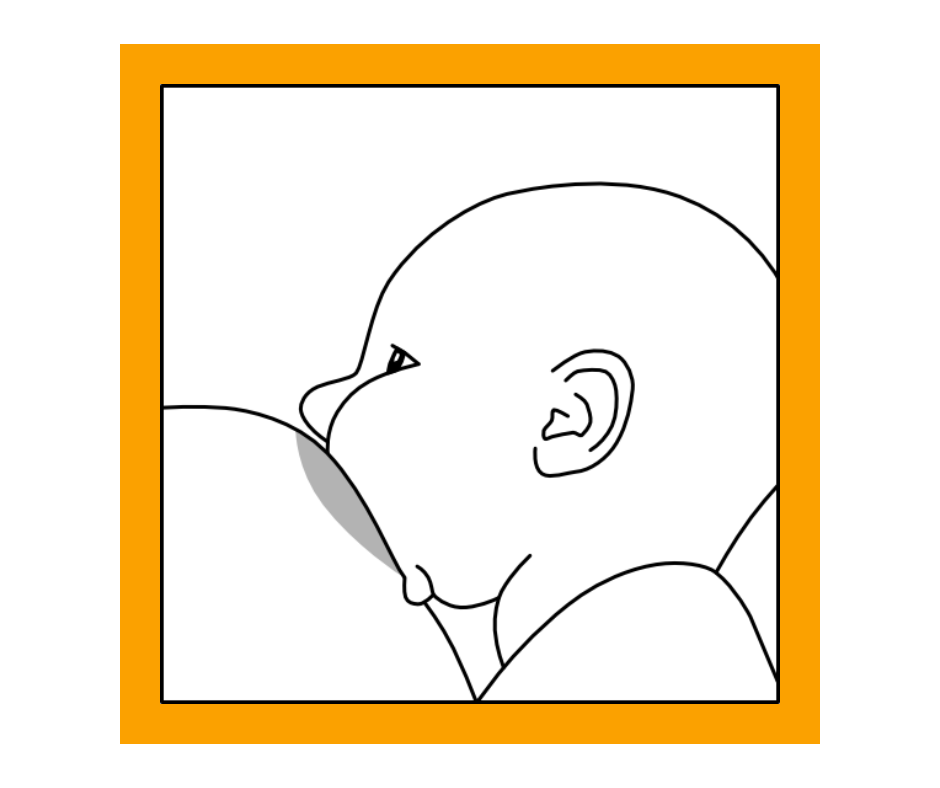
You shouldn’t feel like you have to hold your breast back so your baby can breathe. Chin in, nose tipping away, head back is the same position you take when you drink something. (Try it now, pretend to take a drink of water. See how your chin goes forward and your head tips back?)
Both cheeks touching the breast. If once latched, one cheek is not touching the breast, consider adjusting your baby so that both cheeks are touching your breast. This will help to make sure your nipple is straight and deep into your baby’s mouth.


Adjust your baby as needed. Babies often creep upwards or forwards while feeding.
Helpful Videos
Laid-back position
Latching Your Baby
Adjust your baby as needed. You may need to pull your baby closer to you from behind the shoulder blades, like the mother in this photo.
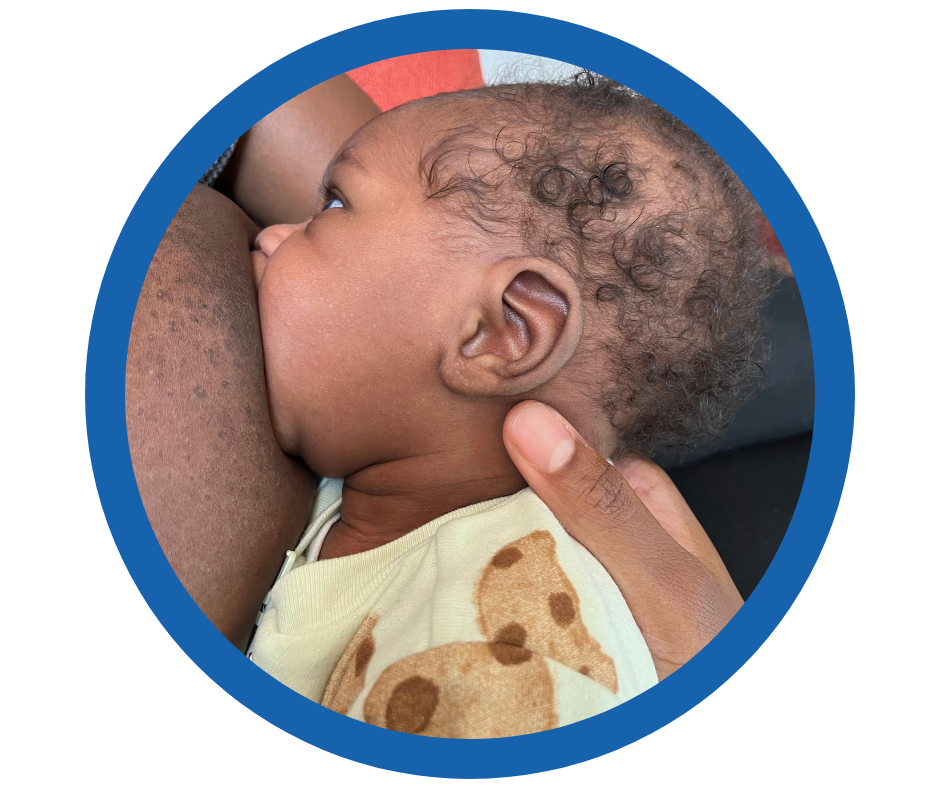
The Nipple Tilt Technique
To get an even deeper latch, you can try using the nipple tilt technique. This is also known as the “flipple” technique. Hold your breast with your thumb on top and your fingers on the bottom. Place your thumb well back from the base of the nipple. This is in line with where your baby’s upper lip will be once she has latched. Make sure your fingers are far away from where your baby’s chin will be. Press in with your thumb. This will tilt your nipple away from your baby. Bring your baby to your breast so that her chin is touching. When your baby reaches up for a big mouthful of breast, release your nipple at the last moment by removing your thumb. This allows your nipple to fall deeply into your baby’s mouth. Avoid pushing your nipple into your baby’s mouth.
Sucking vs Swallowing
There is a difference between sucking drinking” and swallowing. Babies can suck for comfort or to drink. You’ll see chin movement for both. It’s important to know when your baby is swallowing your milk.
Swallowing is the main sign that your baby is getting milk. When there is a mouthful of milk, your baby’s chin will drop with a “pause” in order to swallow. You may hear a “kah” sound as the baby breathes out after a swallow. When your baby is drinking, she has a steady suck, swallow, breathe pattern. Your baby will take short breaks between letdowns of milk. When another letdown of milk occurs, your baby will begin drinking again.
If swallowing or sucking slows down, you can gently squeeze or compress your breast with your whole hand for several seconds. This will increase milk flow and encourage your baby to keep drinking.
For more information see the The Sounds of Breastfeeding.
Other Breastfeeding Positions
There are other breastfeeding positions you may want to use in the early days. Some are easier once you and your baby are experienced at nursing. Remember, if one position is not working for you, try another one.
Cross-cradle hold

The cross-cradle position can be useful in the early days. It gives you more control over the position of your baby and your breast. It is a common hold used when latching a premature or small baby. Once your baby is latched it can be helpful to switch your arms to the cradle position and lean back to allow gravity to help hold your baby onto your breast.
Football or Clutch Hold

The Football or Clutch hold can be helpful if you have had a cesarean birth. It keeps your baby away from your incision. It can also be helpful if you have larger breasts. You can feed two babies at the same time in a double football hold.
Cradle hold

This position may be difficult to master in the early days and weeks but once you are experienced at breastfeeding, it will likely become easier.
Side-lying

The side-lying position is helpful if you are recovering from a cesarean birth or if your bottom is sore after giving birth. It is also extremely helpful for breastfeeding in bed during the night. This position can be a little tricky to master because you have limited use of the arm you are lying on. It is worth practicing as soon as possible so you can nurse lying down. Once you get the hang of it, it makes nighttime and naptime nursing much easier.
For more information on sleeping safely with your baby in your bed see Sleep and the Breastfeeding Family.
What if it hurts?

A deep latch prevents the nipple from being pinched by the tongue and the hard palate of your baby’s mouth. A shallow latch often results in sore nipples. If your baby is not latched correctly, the end of your nipple may be creased, flattened or pinched. It may look like a new tube of lipstick, when it comes out of your baby’s mouth. The end of the nipple may be blanched (white).
If you feel that your baby is not latched well, it is important to deal with it right away, even if other people tell you that the latch looks fine. Pain is your body’s way of letting you know that something is wrong and needs to be changed. A painful latch is usually a shallow one. With a shallow latch your baby is not able to remove milk easily. It is not helpful to suffer through a painful latch. A good, deep latch will be comfortable for you. And your baby will get lots of milk.
In a small percentage of babies, the tongue is restricted because of a tight frenulum, or tongue tie. Because of this the baby may not be able to pull the nipple deeply into the mouth. If the latch is still painful even after trying to improve it, you are encouraged to seek the help of an International Board Certified Lactation Consultant (IBCLC). Then, if necessary, you may want to consult with a healthcare professional who specializes in diagnosing and treating tongue ties. See Tongue and Lip Ties.